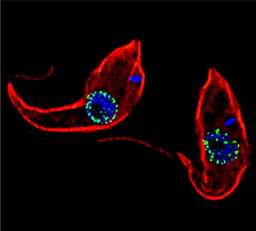
Active
View Entry | Trypanosoma brucei, the cause of sleeping sickness3765| Trypanosoma brucei is a single-cell parasite that causes sleeping sickness in humans. Scientists have been studying trypanosomes for some time because of their negative effects on human and also animal health, especially in sub-Saharan Africa. Moreover, because these organisms evolved on a separate path from those of animals and plants more than a billion years ago, researchers study trypanosomes to find out what traits they may harbor that are common to or different from those of other eukaryotes (i.e., those organisms having a nucleus and mitochondria).
This image shows the T. brucei cell membrane in red, the DNA in the nucleus and kinetoplast (a structure unique to protozoans, including trypanosomes, which contains mitochondrial DNA) in blue and nuclear pore complexes (which allow molecules to pass into or out of the nucleus) in green.
Scientists have found that the trypanosome nuclear pore complex has a unique mechanism by which it attaches to the nuclear envelope. In addition, the trypanosome nuclear pore complex differs from those of other eukaryotes because its components have a near-complete symmetry, and it lacks almost all of the proteins that in other eukaryotes studied so far are required to assemble the pore. | | Public Note | | | | | Internal Note | | Researchers gave permission for public use:
From: Michael P. Rout [rout@mail.rockefeller.edu]
To: Spiering, Martin (NIH/NIGMS) [C]
Wednesday, March 23, 2016 11:27 AM
Hi Martin,
apologies for the delay in getting back to you! Of course, no worries - the image is attached.
The trypanosome membrane is stained in red (tubulin), with the nuclear pore complex highlighted in green (Nup98) and DNA highlighted in blue (DAPI).
Image credit: Dr.Jeffery deGrasse; DeGrasse JA et al., Mol Cell Proteomics. 2009 Sep;8(9):2119-30. PMID: 19525551; Obado SO et al., PLoS Biol. 2016 Feb 18;14(2):e1002365. PMID: 26891179
Hope this is OK - let me know if you need anything else!
Best, Mike.
On Mar 22, 2016, at 12:37 PM, Spiering, Martin (NIH/NIGMS) [C] wrote:
Dear Dr. Rout,
I am a writer and editor with the Office of Communication and Public Liaison at the National Institute of General Medical Sciences. I am reaching out to you because we noticed a very striking image of trypanosomes in this recent news release (http://newswire.rockefeller.edu/2016/03/17/parasites-reveal-how-evolution-has-molded-an-ancient-nuclear-structure/) describing your research advance on the structure of the nuclear pore complex in these organisms. We would be very grateful if we could include your artwork in our Image Gallery on the NIGMS website (at https://images.nigms.nih.gov/).
Images and videos in the NIGMS Image Gallery highlight NIGMS-funded work and are made available to the public for educational uses, provided that users credit the creator, i.e., you, for this work. Would you let us feature your work in our image gallery in this way? If so, could you send us a high-resolution version of your image? Please let me know if you have any questions. | | | Keywords | | | | | Source | | Michael Rout, Rockefeller University | | | Date | | 2016-03-23 00:00:00 | | | Credit Line | | Jeffrey DeGrasse, Rockefeller University | | | Investigator | | Michael Rout, Rockefeller University | | | Record Type | | Photograph | | | Topic Area(s) | | ;#Cells;#Genes;# | | | Previous Uses | | | | | Status | | Active | |
| | View All Properties | | Edit Properties |
|
